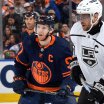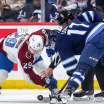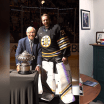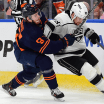Bradley had never seen a crowd like it.
"It was just jammed," Bradley said. "A lot of rinks could hold 18,000 or 20,000, but we had 28,000 people going crazy. The place was rocking. It was really exciting, and it got us revved up."
Most of those people undoubtedly hoped to see the Lightning win their third straight game against the Flyers. Instead, Philadelphia's "Legion of Doom" line dominated in a 4-1 series-tying victory.
"We played well," Bradley said. "But Daren Puppa, our top goalie, was injured, and without your goaltender it's tough. But the 'Legion of Doom,' with [John] LeClair and [Mikael] Renberg and [Eric] Lindros -- they had a great team. They were a very tough team, very physical."
LeClair scored two power-play goals for the Flyers, who limited the Lightning to 22 shots on goal against Ron Hextall. Petr Klima's power-play goal midway through the second period brought the Lightning within 2-1, but Dale Hawerchuk deflected Renberg's pass behind goaltender Jeff Reese late in the period and LeClair scored his second goal midway through the third.
After a 4-1 loss in Philadelphia and a 6-1 home defeat in Game 6, the Lightning were done for the season.
"We lost [the series] 4-2, but it was very respectable," Bradley said. "At the end, they knew it was a tough series. It wasn't like they walked over us. It was a hard-fought series to the very end."
It also was the end for the Thunderdome, at least when it came to the NHL. It was renamed Tropicana Field in October 1996 and became the home of MLB's Tampa Bay Devil Rays (now the Rays) in 1998.
The Lightning moved into their new arena, then called the Ice Palace, in the fall of 1996, taking their playoff attendance record with them.


















